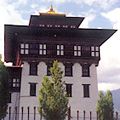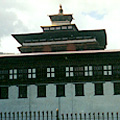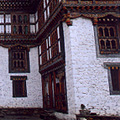Traditional architecture in Bhutan is characterized by the use of natural local materials such as rammed earth, bamboo, local timbers, and stone and has adapted to the local topography, climatic conditions and most importantly, cultural traditions and religious beliefs.
Stone arts are used in the construction of the outer walls of large fortresses (Dzongs), temples (Lhakhangs), monasteries (Goenpas), stupas (choetens), palaces, and other buildings.
Dzongs
The Dzongs (fortresses), located in each valley in Bhutan at strategic places, with their massive stone walls, large courtyards and beautiful wood work on windows and cornices are the most striking among the diverse architectural expressions of the country.
The making of these stone walls gave rise to a craft of its own, stone masonry. The task was to work a block out of a rock, which fits next to, and on top of, another stone. The senior master-mason (zope) makes the plans and supervises the angles in building a wall.

Stupas
The most common architectural feature of Bhutan’s countryside is the chorten or stupa. A chorten literally means a receptacle of worship or offering. Following his cremation, the relics of the Buddha were divided among eight groups of claimants, each of which erected a reliquary. This marked the origin of these structures, which came to be known as stupas. While initially stupas were meant only to house the relics of the Buddha and other Buddhist saints, later they acquired a deeper significant and symbolism. Building a stupa came to be considered an act of great piety, earning merit for the actual builders as well as for those who paid for them. A stupa is not considered as an inanimate objects but as a support of faith.
Chortens are sometimes linked by long thick stone walls called mani (prayer walls, which are inscribed with religious paintings and prayers).

Houses
The construction materials and the plan of the house differ from region to region – depending on the climate and the topography. Although normal indigenous houses of farmers were two stories high, an ideal house was one that had three main floors and an attic, with each level having distinctive functions.
Houses in Southern Bhutan are ridged roofed and rectangular with outer walls of stones and rammed mud finished with plaster. The inner walls are of closely woven bamboo matting.
In Bumthang houses of stone rather that rammed earth and more sparsely decorated. In the East, houses are built traditional Bhutanese style but one can see many made of bamboo matting and raised on stilts. The semi nomadic Yak herders of Lungshi, Laya in the Northern areas build dry stone walled houses.
Walls are made of stone and wood or stone, wood and rammed earth. Thick rammed earth or stone masonry walls create formally enclosed volumes of spaces which resonate having escape out to the exterior through very narrow timber window on the lower floors and larger elaborately painted timber windows on the top floor.
State buildings are now using hollow cement blocks for walls.
Gallery
YOUR VIEWS
PRACTITIONERS: INDIA
Access 70,000+ practitioners in 2500+ crafts across India.
BIBLIOGRAPHY
10,000+ listings on arts, crafts, design, heritage, culture etc.
GLOSSARY
Rich and often unfamiliar vocabulary of crafts and textiles.
SHOP at India InCH
Needs to be written.






